Westport's High Pressure Direct Injection System - GAS Doctor, GPL ...
Westport's High Pressure Direct Injection System - GAS Doctor, GPL ...
Westport's High Pressure Direct Injection System - GAS Doctor, GPL ...
Create successful ePaper yourself
Turn your PDF publications into a flip-book with our unique Google optimized e-Paper software.
<strong>Westport's</strong> <strong>High</strong> <strong>Pressure</strong> <strong>Direct</strong> <strong>Injection</strong> <strong>System</strong> —<br />
Technology and European Certification<br />
March 30, 2010
A Global Leader in Alternative Fuel<br />
Transportation Technologies<br />
• Technology developed at the University of British<br />
Columbia, Vancouver, Canada<br />
• Westport founded in 1995<br />
• A world leader in heavy-duty gaseous fuel engine<br />
technology (natural gas, hydrogen, LPG, biogas)<br />
– Over 25,000 engines sold to customers in 35 countries<br />
– More than 60 OEM vehicle manufacturers in 20 countries<br />
offer our engines/fuel systems<br />
• > Over 200 employees worldwide<br />
• $122 million F2009 revenue<br />
• Publicly-traded TSX:WPT, NASDAQ:WPRT<br />
• $630 million market capitalization<br />
• Global partnerships in China, Europe, USA<br />
2
Recognized Leadership<br />
3<br />
3
Westport‘s Market Segments<br />
Segment & Westport<br />
Business Unit<br />
Light Duty<br />
1 – 5 litre<br />
Products<br />
Partners<br />
Mid-Range<br />
5.9 – 10 litre<br />
60 bus and truck<br />
OEM partners<br />
world-wide<br />
Heavy Duty<br />
11 – 16 litre<br />
4<br />
4
Westport‘s <strong>High</strong> <strong>Pressure</strong> <strong>Direct</strong><br />
<strong>Injection</strong> (HPDI) Philosophy<br />
Keep the engine…<br />
• Rudolf Diesel‘s concept: <strong>Direct</strong> injection, diffusion<br />
combustion<br />
– At high load, no danger of knock:<br />
• <strong>High</strong> compression ratio Efficiency same or better than diesel<br />
(lower fuel costs, lower CO 2 emissions)<br />
• <strong>High</strong>ly boosted operation <strong>High</strong> performance (true heavyduty<br />
applications, fully match the torque curve)<br />
– At low load, no problems with the lean flammability limit:<br />
• <strong>Direct</strong> injection Leanest air-fuel ratios possible <strong>High</strong><br />
efficiency<br />
• No throttling <strong>High</strong> efficiency<br />
– Other benefits:<br />
• <strong>Direct</strong> injection Responsive performance<br />
• Diesel pilot No spark plugs to worry about<br />
• Diesel pilot An extremely robust ignition source<br />
• Only air, no fuel, is compressed on compression stroke Low<br />
engine-out CH 4 emissions<br />
…but change the fuel<br />
• Shift to natural gas<br />
– Environment: Lowest-carbon hydrocarbon fuel Lower GHGs<br />
– Energy security: Vast (and rapidly increasing) natural supply, more uniform<br />
distribution globally, larger supplies in western countries Energy security<br />
– Economics: Lower cost fuel Operating cost savings<br />
5
The HPDI Fuel <strong>System</strong><br />
• A complete natural gas fuel system for<br />
heavy-duty engines, with dieselequivalent<br />
performance and efficiency<br />
• Capable of independently injecting<br />
diesel and gas at up to 300 bar<br />
• The diesel quantity is approximately<br />
constant at all conditions, just enough<br />
to provide energy for robust ignition;<br />
the gas quantity is controlled to vary<br />
the engine power<br />
more information is available at<br />
www.westport.com and www.westport-hd.com<br />
• The HPDI injector is not designed to<br />
allow diesel-only operation (other than<br />
low-torque operation for a few minutes<br />
to drive off the railway track or move<br />
around in the repair shop)<br />
• This has regulatory benefits in some<br />
jurisdictions that want to ensure that<br />
their natural gas engines actually are<br />
running on natural gas<br />
6<br />
6
Hundreds of Kenworth Trucks with HPDI<br />
Engines are in Commercial Service<br />
CONFIDENTIAL<br />
7
Crude oil price [US$/barrel]<br />
Diesel and natural gas fuel prices [US$/gallon]<br />
Economics:<br />
Vehicle Fuel Price History<br />
Fuel Price History for Crude Oil, Diesel Fuel, and Vehicular CNG in The USA<br />
$160<br />
$120<br />
$80<br />
World crude oil spot price (EIA)<br />
Retail diesel fuel (EIA)<br />
Retail diesel fuel (CCAFPR)<br />
Retail CNG (CCAFPR)<br />
data sources: US DOE<br />
Energy Information Administration<br />
(EIA) and Clean Cities Alternative Fuel<br />
Price Report (CCAFPR)<br />
$5.00<br />
$4.50<br />
$4.00<br />
$3.50<br />
$3.00<br />
$5.00<br />
$4.50<br />
$4.00<br />
$3.50<br />
$3.00<br />
R 2 = 0.9688<br />
R 2 = 0.9782<br />
diesel-CNG<br />
price gap<br />
$2.50<br />
$2.50<br />
R 2 = 0.7163<br />
$40<br />
$2.00<br />
$2.00<br />
$-<br />
Jan-<br />
00<br />
Jan-<br />
01<br />
Jan-<br />
02<br />
Jan-<br />
03<br />
Jan-<br />
04<br />
Jan-<br />
05<br />
last update Mar 11, 2010<br />
Jan-<br />
06<br />
Jan-<br />
07<br />
Jan-<br />
08<br />
Jan-<br />
09<br />
Jan-<br />
10<br />
$1.50<br />
$1.00<br />
$1.50<br />
$1.00<br />
Retail diesel fuel (EIA)<br />
Retail diesel fuel (CCAFPR)<br />
Retail CNG (CCAFPR)<br />
$- $20 $40 $60 $80 $100 $120 $140 $160<br />
Crude oil price [US$/barrel]<br />
• Diesel fuel prices rise and fall with crude oil prices – there‘s a high degree of correlation<br />
• Natural gas prices also correlate with crude oil prices (although less strongly)<br />
• As oil prices rise, the diesel-natural gas price gap widens, increasing HPDI‘s fuel cost savings<br />
8
Crude oil price [US$/barrel]<br />
Diesel and natural gas fuel prices [US$/gallon]<br />
Economics:<br />
Vehicle Fuel Price Projections<br />
$200<br />
$160<br />
Fuel Price History and Projections for Crude Oil, Diesel Fuel, and Vehicular CNG in The USA<br />
World crude oil spot price (EIA)<br />
EIA projections to 2035, Crude oil [$/bbl]<br />
Retail diesel fuel (EIA)<br />
Retail diesel fuel (CCAFPR)<br />
Retail CNG (CCAFPR)<br />
EIA projections to 2035, CNG for vehicles [$/DEG]<br />
EIA projections to 2035, Diesel fuel [$/gal]<br />
$7.00<br />
$6.00<br />
$5.00<br />
$7.00<br />
$6.00<br />
$5.00<br />
Retail diesel fuel (EIA)<br />
Retail diesel fuel (CCAFPR)<br />
Retail CNG (CCAFPR)<br />
EIA projections to 2035, Diesel fuel [$/gal]<br />
EIA projections to 2035, CNG for vehicles [$/DEG]<br />
data sources: US DOE Energy Information<br />
Administration (EIA) and Clean Cities Alternative Fuel<br />
Price Report (CCAFPR); projections from "Annual<br />
Energy Outlook 2010 Early Release"<br />
$120<br />
$80<br />
diesel-CNG<br />
price gap<br />
$4.00<br />
$3.00<br />
$4.00<br />
$3.00<br />
diesel-CNG<br />
price gap<br />
2030<br />
2035<br />
$40<br />
$2.00 $2.00<br />
last update Mar 11, 2010 2015<br />
2020<br />
2025<br />
$-<br />
history<br />
EIA projections<br />
2000 2005 2010 2015 2020 2025 2030 2035<br />
$1.00<br />
• The US Energy Information Administration (EIA)‘s projections to 2035 show the same<br />
relationships among prices of crude oil, diesel fuel, and natural gas<br />
• The price gap will continually widen every year, approximately in line with historical trends<br />
• Recently, large quantities of ―shale gas‖ have greatly increased US natural gas reserves<br />
$1.00<br />
$- $50 $100 $150 $200<br />
Crude oil price [US$/barrel]<br />
9
Environment:<br />
Heavy-duty Trucks Are Important<br />
• According to NASA‘s Goddard Institute for<br />
Space Studies, on-road transportation is the<br />
largest driver of climate change, and CO 2 is<br />
the most important chemical species<br />
• Fuel use translates directly to CO 2 emissions,<br />
and according to the US Department of Energy,<br />
heavy-duty trucks are one of the largest<br />
consumers of petroleum fuels, with Class 8<br />
(>15t) trucks accounting for nearly 70% of that<br />
Climatic Forcing by Economic Sector<br />
source: Research and<br />
Development Opportunities for<br />
Heavy Trucks, US DOE, June 2009.<br />
source: Unger et al, Attribution of climate forcing to economic sectors,<br />
Proceedings of the National Academy of Sciences, PNAS 2010 107 (8) 3382-<br />
3387, www.pnas.org/cgi/doi/10.1073/pnas.0906548107<br />
10
Tank-to-wheels BSGHG (CO2eq) [g/kW.h]<br />
Environment:<br />
CO 2 and GHG Benefits of HPDI<br />
700<br />
600<br />
500<br />
400<br />
300<br />
200<br />
100<br />
0<br />
Illustrative GHG Emissions at Euro VI<br />
Assume HPDI just meets ETC PI CH 4 limits<br />
Diesel<br />
Westport HPDI<br />
source: Westport estimates<br />
Engine efficiencies depend on engine duty cycle<br />
BSGHG from CH4 (=25*BSCH4) [g/kW.h]<br />
BSCO2 emissions [g/kW.h]<br />
~ 22%<br />
reduction<br />
• Diesel engines are the most efficient<br />
engines in common use, but diesel fuel<br />
contains a lot of carbon<br />
• Natural gas has the lowest carbon content<br />
of any hydrocarbon fuel<br />
• Westport‘s HPDI philosophy: ―keep the<br />
engine but change the fuel‖<br />
– HPDI‘s efficiency is the same as or better<br />
than a diesel engine‘s<br />
– HPDI uses low-carbon natural gas fuel to<br />
provide ~ 94% of the energy on average (~<br />
97% at maximum power)<br />
– So HPDI reduces CO 2 emissions by ~ 24%<br />
– Even adding the low CH 4 emissions<br />
permitted for ―gas engines‖ under European<br />
regulations (0.5 g/kW.h at Euro VI), HPDI<br />
would reduce total GHG (=CO 2 +25*CH 4 )<br />
emissions by ~ 22%<br />
• Regulation of CO 2 or total GHGs<br />
(=CO 2 +25*CH 4 ) would benefit most gas<br />
11<br />
engines
Environment: First Global Carbon<br />
Finance Program for Transportation<br />
• Monetizing CO 2 reductions is a challenge for truck<br />
fleets<br />
– Cost: A project is cost-prohibitive for all but the largest<br />
fleets<br />
– Regulatory uncertainty: Will transportation be included?<br />
– Quantification and verification: More difficult for mobile<br />
sources<br />
– Complexity: IPCC defaults and actual EPA results<br />
– How to price the CO 2 ?<br />
• Westport recently announced the world‘s first CO 2 finance program for transportation, to be<br />
registered to the Voluntary Carbon Standard (VCS)<br />
• The Westport Carbon Project allows truck operators to realize additional financial value<br />
from the decision to purchase a natural gas vehicle via rebate cheques from Westport<br />
• All voluntary carbon units (VCU) are real, measurable, permanent, additional, conservative,<br />
independently verified, unique, and transparent<br />
• Westport will bundle CO 2 reductions from truck operators that use our engines and re-sell<br />
CO 2 offsets to those wishing to buy them<br />
• This validates the emissions reduction of Westport engines and further supports the<br />
economic and environmental value proposition we offer to customers<br />
12
HPDI Certification:<br />
USA & Australia (1)<br />
• HPDI offers environmental and cost benefits, but how to emissions-certify it?<br />
• Many ―alternative fuels‖ technologies are retro-fits, but HPDI is not a retro-fit, it is a<br />
new-OEM product offered as a factory option in Kenworth and Peterbilt trucks<br />
• Recognizing the value of HPDI and its uncertain regulatory situation, California<br />
crafted a definition that would allow HPDI to certify, without any special emissions<br />
exemptions and that is technology-neutral and fuel-neutral<br />
‗"Heavy-duty pilot ignition<br />
engine" means an engine<br />
designed to operate using an<br />
alternative fuel, except that<br />
diesel fuel is used for pilot<br />
ignition at an average ratio of<br />
no more than one part diesel<br />
fuel to ten parts total fuel on<br />
an energy equivalent basis. An<br />
engine that can operate or idle<br />
solely on diesel fuel at any<br />
time does not meet this<br />
definition.‘<br />
The definition applies to alternative-fuel engines<br />
but is technology-neutral and fuel-neutral (natural<br />
gas is not mentioned)<br />
Diesel fuel is allowed but restricted to pilot<br />
ignition only<br />
Fuel substitution is specifically restricted to a high<br />
average value on an energy-equivalent basis<br />
Operation (even idling) on diesel only is<br />
specifically prohibited<br />
source: California Code of Regulations, Title 13, Section 2020<br />
13
HPDI Certification:<br />
USA & Australia (2)<br />
• USA<br />
– HPDI is emissions-certified in the USA to below<br />
EPA 2007 and in California to below CARB 2007<br />
• HPDI: NOx 0.8 g/bhp-hr (1.07 g/kW.h), PM 0.01 g/bhp-hr (0.013 g/kW.h)<br />
– Certification to 2010 standards expected soon<br />
• NOx 0.2 g/bhp-hr (0.268 g/kW.h), PM 0.01 g/bhp-hr (0.013 g/kW.h)<br />
• Australia<br />
– HPDI is emissions-certified in Australia to Australian<br />
Design Rules (ADR) 80/02 (= Euro 4 or US04)<br />
– Certification to ADR80/03 (= Euro 5 or US07) is<br />
coming in 2011<br />
14
Certification Regulations:<br />
Europe (1)<br />
• UN/ECE Regulation 115<br />
– UN/ECE Regulation 115 applies specifically to retro-fits and CNG<br />
– HPDI is not a retro-fit product<br />
• New-OEM type approval<br />
– HPDI is a new-OEM product, offered today in Kenworth and Peterbilt<br />
trucks as factory options<br />
– Work is in progress with Volvo, Weichai, and others<br />
– HPDI engines derive ~ 94% of their energy from natural gas (~ 97% at<br />
maximum power)—they are clearly gas engines<br />
– Under new-OEM regulations:<br />
• ‗gas engine‘ means an engine which is fuelled with natural gas (NG) or liquid<br />
petroleum gas (LPG) (<strong>Direct</strong>ive 2005/55/EC);<br />
• but this definition was amended in Commission <strong>Direct</strong>ive 2005/78/EC: ―gas<br />
engine‖ means a positive-ignition engine which is fuelled with natural gas<br />
(NG) or liquefied petroleum gas (LPG);<br />
• (there seems to be no legislative definition of ―positive-ignition‖?)<br />
15
Certification Regulations:<br />
Europe (2)<br />
• Possible approaches for Europe:<br />
– The Euro VI emissions limits have already been set in Regulation (EC)<br />
No 595/2009; these appear more amenable to alternative fuels: ―It is<br />
appropriate to encourage the introduction of alternative fuel vehicles‖<br />
– And include the definition that ―alternative fuel vehicle‘ means a<br />
vehicle designed to be capable of running on at least one type of fuel<br />
that is either gaseous at atmospheric temperature and pressure, or<br />
substantially non-mineral oil derived;‖<br />
– But most of the Euro VI definitions have not been published yet<br />
– One approach could be to revise the definition of ―gas engine‖ to<br />
include something similar to that used by California<br />
– Another approach could perhaps add a new definition of a ―pilotignited<br />
gas engine‖ as a new type of ―gas engine‖, again similar to that<br />
used by California<br />
– A third approach might be to clarify ―diesel pilot ignition‖ as a form of<br />
―positive ignition‖, again similar to California, since ―positive ignition‖<br />
seems not to be specifically defined<br />
16
Summary<br />
• Westport‘s HPDI technology offers significant environmental, energy security,<br />
and economic benefits<br />
• But emissions regulations were written, naturally enough, with standard<br />
technologies in mind<br />
• Westport has overcome uncertainties in certification in other jurisdictions by<br />
demonstrating HPDI‘s benefits and working with regulators to address their<br />
concerns<br />
• California‘s successful approach may be a good model:<br />
– Create a new definition, probably easier and faster than a whole new set of<br />
emissions limits<br />
– Design the definition to<br />
• permit two fuels, but restrict diesel fuel to ―pilot ignition‖ only<br />
• require a high percentage of fuel substitution (of natural gas, in our case)<br />
• prohibit diesel-only operation (another option would be to allow diesel-only operation but<br />
require the engine to meet diesel emissions limits when operating in diesel-only mode)<br />
– No special emissions exemptions, technology-neutral, and fuel-neutral<br />
• Possible approaches for Europe:<br />
– While the emissions limits for Euro VI have already been set, most of the definitions<br />
have not<br />
– As in California, the best approach might be to work on the definitions<br />
17







